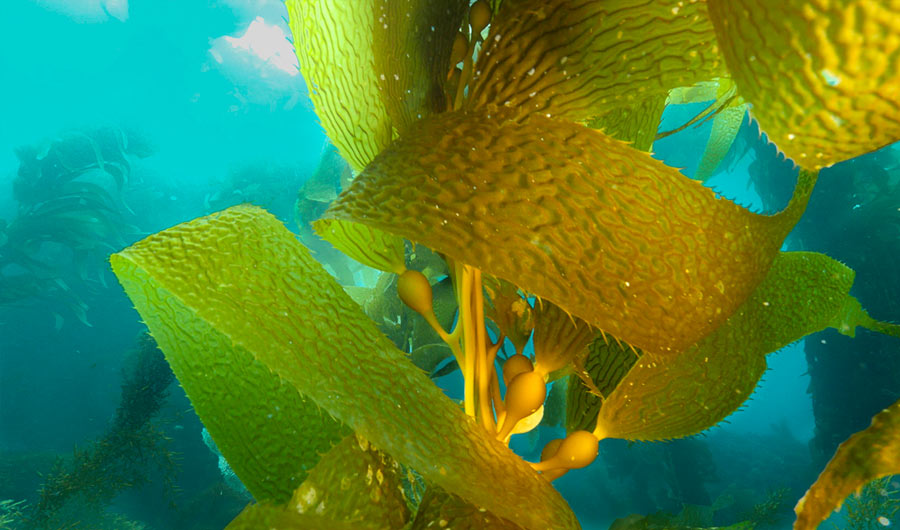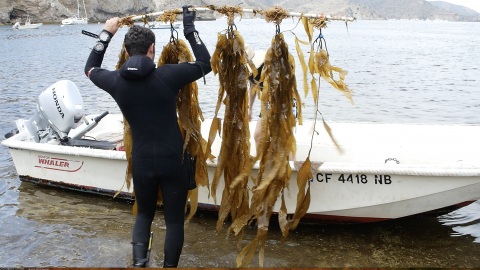Kelp Elevator Could Give Biofuels a Lift

Image credits: Maurice Roper, USC Wrigley Institute
Inside Science -- Catalina Island, 25 miles off the coast of Los Angeles, is known for pristine coastlines, epic snorkeling, and panoramic views of the Pacific. Its waters are also home to an unsual-looking science experiment: a floating bed of planted kelp that is pushed down and pulled up each day, as if riding a giant elevator.
The idea behind the project is to find an efficient way to farm kelp for fuel. The ribbonlike sea vegetable requires a minimum of resources -- no soil, no fresh water, no fertilizer -- and can grow up to 2 feet each day, earning it the nickname “the Sequoia of the sea.” Ultimately, the kelp would be harvested and turned into a petroleum substitute called biocrude.
The system of transportation and production for biocrude -- from pipes to refineries -- is already in place, said Diane Kim, a marine biologist at the USC Wrigley Institute for Environmental Studies, but the industry has been limited by the inability to produce and harvest enough plants, algae and other organic material to turn into fuel.
That’s where the kelp experiments come in. A company called Marine BioEnergy Inc. is collaborating with a research team at the Wrigley Institute, using funding from the U.S. Department of Energy, Advanced Research Projects Agency -- Energy to conduct proof-of-concept testing.
Kelp naturally grow in shallow coastal waters where they anchor themselves to the sea bed. In order to produce lots of it, though, the macroalgae would need to be grown in giant patches of the open ocean. That’s because coastal waters are coveted for recreation and are home to lots of other species. The open ocean has the room for kelp farms that coastal waters lack, but the two main elements that kelp requires -- sunlight and nutrients -- are spatially separated there. Sunlight is near the ocean’s surface, while nutrients are found in abundance hundreds of feet down.
To address this challenge, the researchers created an anchored buoy attached to a machine that pulls the kelp up to the surface during the day, and then pushes it 80 meters (262 feet) deep at night to bathe in nutrient-rich colder waters.
To test how the plants reacted to the elevator, they planted baby native kelp on rope and attached it to 30-foot-long plastic PVC pipes in three different areas. Two were in the shallow waters where kelp typically grows, and one was in deeper water, where it was cycled up and down each day by the machine. The whole offshore apparatus was tethered to the ground 140 meters (459 feet) below the surface.
At the end of 3 ½ months, the researchers pulled up the kelp and measured it. To their surprise, the open-water kelp grew bigger than the shallow-water kelp, up to three times longer. Part of the reason they did so well was that the kelp in the open water had fewer predators, said John Heidelberg, a biologist at the Wrigley Institute. He showed a group of visiting journalists a mock-up of the elevator on a recent trip to the island. “There’s not a lot out there eating it,” he said.
“I didn’t know what to expect,” added Kim, who is part of the team heading up the biofuel research. “I thought this excursion down to 80 meters every day probably wouldn’t kill the kelp, but we didn’t know how they would develop.” In a previous test, the gas-filled balls that naturally grow at the top of the kelp imploded at 40 meters down. The researchers said that it could be the slow cycling allowed the kelp to develop balls that didn’t burst.
This is just one experiment, but it is very encouraging, Kim said. They plan to repeat the tests in the coming months, and they’ll publish their results when they’ve crunched all the numbers. Scaling up the operations would also require creative thinking about how to manage big storms, invasive species and other environmental factors. Eventually, an autonomous network of kelp farms could float off the coasts of U.S. states, pulled up and down by drones and harvested by large ships to be processed into biocrude.
Not everyone agrees that biofuels should be a central part of a future energy system, though. “Biofuels are combusted just as gasoline and diesel fuels are, and combustion creates air pollution that kills and injures people,” said Stanford environmental engineer Mark Z. Jacobson. “Whether such emissions are slightly less or more than from fossil fuels is irrelevant, since they are always far greater than from electric vehicles, which eliminate 100% of tailpipe emissions.”
He adds that photosynthesis is only 1% efficient, while solar photovoltaic panels are 20% efficient -- so a solar panel needs one-twentieth the area of a biofuel farm to produce the same energy.
Kim said that kelp farms are not a cure-all for the world’s energy issues, but it’s a step in the right direction, considering that the infrastructure for the production and distribution of biofuels is already in place. “Compared to digging up things that took millions of years to form, we’re getting much closer to a carbon-neutral source of energy,” she said.
Disclosure: USC provided subsidized transportation to Catalina Island and a tour of the Institute mentioned in this story.

